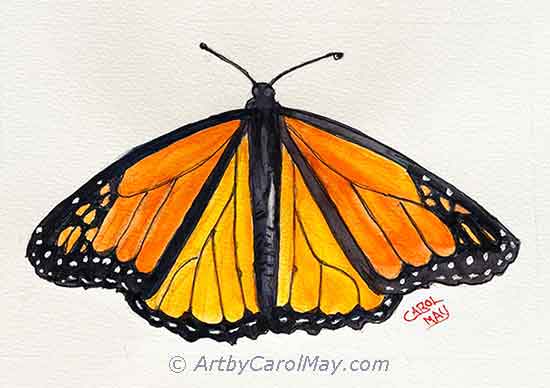- Home
- Begin Oil Painting
oil painting for beginners: a step-by-step tutorial to start painting
Oil painting for beginners is easy!
Learn how to use oil paints while painting a brilliant Baltimore Oriole with Dogwood flowers.
Oil paintings have been a preferred painting medium for centuries. They last for years. Your grandchildren will enjoy your paintings years later.
Oils display an unsurpassed richness. They can be painted with a variety of techniques, from smooth portraits to highly textured landscapes.
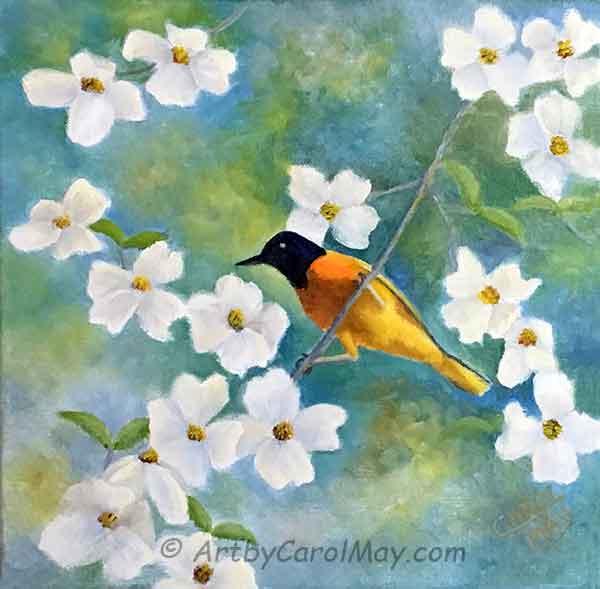 Oriole 'n' Dogwood
Oriole 'n' Dogwoodwhat do you need for oil painting?
- Paint and a palette
- Brushes
- A surface to paint on
- Solvent
- Paper towels
What is the best oil paint?
Professional, artist paints are recommended. They contain more pigment, so they cover better.
The paint is laid out on a palette before painting. A palette paper works well. In a pinch you can use a glass or Styrofoam plate.
How long does it take oil paintings to dry? Oil paintings may be handled in a few days, but they take months to dry thoroughly.
Alkyd paints look and handle like oil paints and they dry completely overnight. All my 'Oil' paintings are done with Griffin Alkyds made by Winsor & Newton.
View the answers to Oil Painting Questions
brushes and canvas
Natural hog hair brushes are the first choice for oil painting. Synthetic brushes are also a good choice.
In this painting I used Winsor & Newton synthetic Galeria brushes, #4, #8 and #12 flats. Any bristle brushes of comparable sizes would be just fine.
Beginning oil painters may use any canvas, canvas board or canvas paper. This painting is on a gallery-wrapped stretched canvas.
Learn more about Oil Painting Supplies
solvent and paper towels
Solvent is used for thinning your paint and cleaning your brushes.
Gamsol, odorless mineral spirits is recommended for studio use. Store the solvent in a container with a lid.
Oil painting for beginners includes cleaning your brushes.
Wipe the excess paint off with a paper towel. Then swish the brush in the solvent and wipe it on a paper towel. If you see color on the towel, repeat.
light and ventilation
The perfect light for painting is a north light window. If you are starting oil painting for beginners any natural daylight is good.
The next best option is using daylight light bulbs to light your painting area. Florescent bulbs will skew your painting colors so they don't look good in natural daylight.
Make sure you have good ventilation in your painting area.
your subject
Artists may paint out of their memory, imagination, life or photos.
This painting used two photographs, Dogwood flowers and an Oriole hanging on the bird feeder.
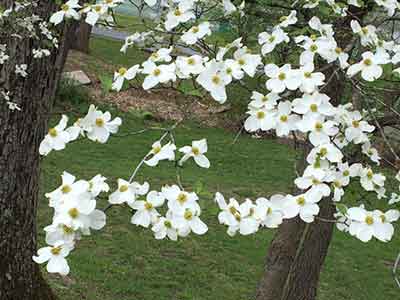 Dogwood Flowers
Dogwood Flowers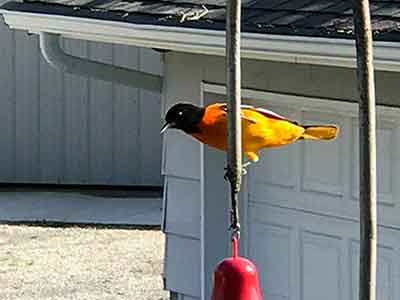 Baltimore Oriole
Baltimore Orioleoil painting for beginners
Put a line drawing on the canvas. Use paint that is thinned with a little solvent or an ordinary pencil.
You may do the drawing on paper first and transfer it to the canvas with graphite paper.
your paint colors
Lay out your colors on a palette. Disposable paper palettes are very handy for oil painting for beginners.
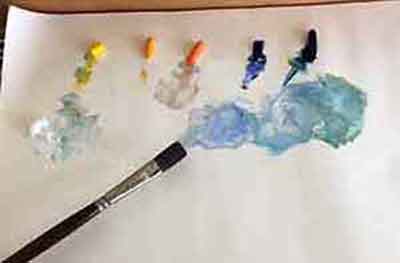 Mixing blue and green for the background.
Mixing blue and green for the background.- A warm and cool yellow - Indian Yellow and Lemon Yellow
- Orange
- A warm and cool blue - Ultramarine Blue and Thalo Blue
- Titanium white
This painting uses an analogous discord color scheme.
paint the background
Use a #12 flat brush to paint the background.
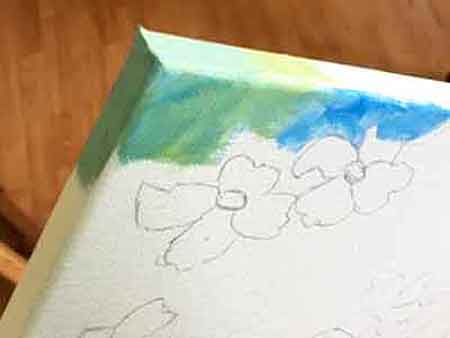 Start painting the background.
Start painting the background.- Paint a variation of warm and cool blues mixed with white.
- Make some greens by mixing yellow with the blues.
Mix your colors lightly on the palette. More mixing occurs on the canvas while you are painting.
Gallery-wrap canvas is stapled onto the back, so the sides of the canvas can be painted. Carry the colors from the face of the canvas over the sides of the canvas.
The finished painting may then be displayed without a frame.
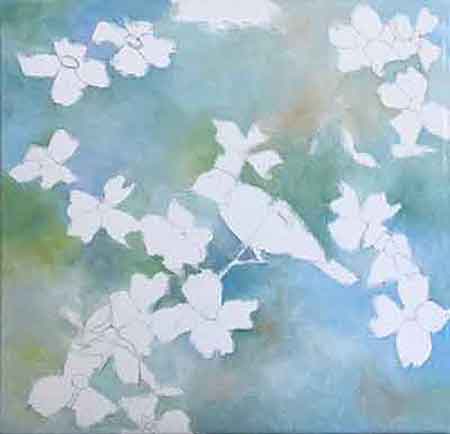 Paint around the bird and flowers.
Paint around the bird and flowers.Use a variation of greens and blues throughout the background.
- It's a good idea to repeat colors in a painting. So, occasionally put in some orange or yellow to indicate light and warmth shining thru the background.
- The orange and yellow help warm up the cool background. That ties it together with the warm colored bird.
- Softly blend the background colors together.
The various background colors suggest things in the distance without having to paint any details. This makes oil painting for beginners easier.
paint the Baltimore oriole
We paint the bird with various yellows and oranges.
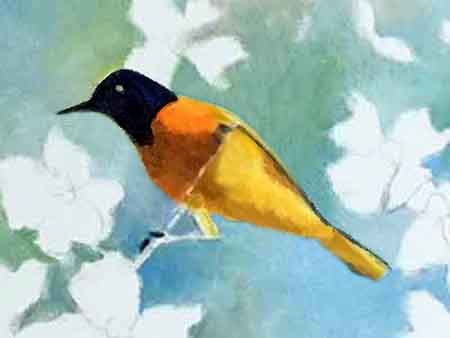 A close-up of the Baltimore Oriole
A close-up of the Baltimore OrioleUse a #8 flat brush to paint the bird's body. Make the colors brighter and warmer on the sunlight side.
We will let the paint set a bit before doing the left leg and eye.
- Mix a black from your blue and orange and paint the head.
Use the #4 brush to paint the beak and toenails black.
Always mix your dark colors with the colors used in the rest of your painting. When you mix your own black, it will harmonize with the rest of the painting.
How do we master mixing paint colors?
Oil painting for beginners is fun when we don't stress out by trying to be perfect.
Just have fun!
paint the flowers
Use the #8 brush for the flower centers.
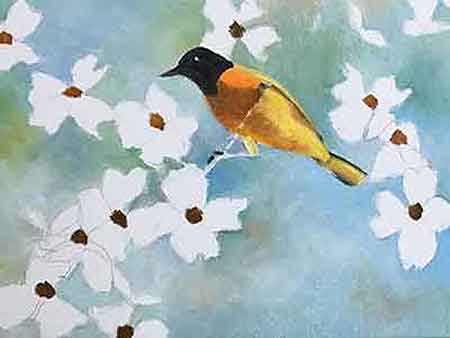 Paint the flower centers
Paint the flower centersWhen you do oil painting for beginners always use the largest brush possible. This keeps your painting loose.
Mix a brown from Ultramarine Blue and orange for the centers.
Casually dab on the flower centers. They are not round circles.
Then highlight the centers with yellow. (Next photo)
Vary the centers, some are more yellow, others are darker or a mixture of dark and light.
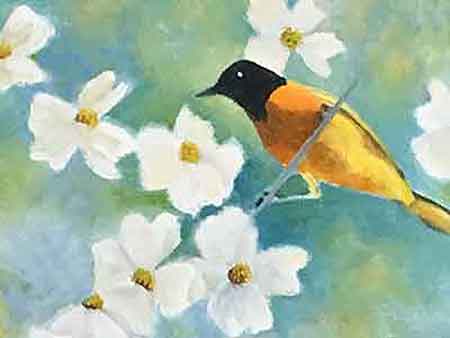 Next paint the petals
Next paint the petalsMix a grey by adding white to the brown you used for the flower centers.
- Paint the petals a soft grey. Add more blue if necessary to keep the grey on the cool side.
- Mix yellow or orange with white to make a warm white.
- Paint the sides of the petals that would be catching sunlight with the warm white.
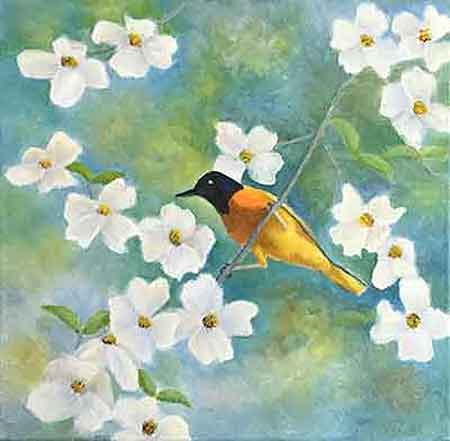 Start the leaves and stems.
Start the leaves and stems.Mix some green and paint a few leaves with light and dark areas.
Spot out where you will paint the branches and leaf stems.
Use the old trick of how to do oil painting for beginners. Turn the painting over and look at it upside down.
It will give you a fresh look to see any mistakes.
The background was a bit light, so I darkened it for more value contrast.
finishing touches
the oriole
Paint his legs with a light grey. Mix a grey with blue and orange plus white to lighten it.
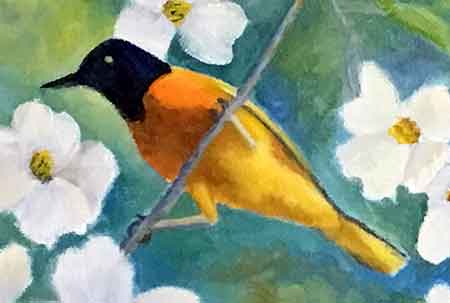 Complete the Oriole
Complete the Oriole- Paint his black toenails hanging over the branch.
- Touch a bit of color in the eye. Use a very pale yellow white on the top of the eye. Put a bit of pale blue-white on the bottom of the eye.
paint the stems
- Paint the Dogwood branches and stems.
Mix light and dark greys with Ultramarine Blue and orange plus white.
In doing oil painting for beginners, it's important to note the light source. The light is from the right. So the branch is lighter on the right and dark on the left side.
Give the branches a light and a dark side to make them look rounded.
do the flowers have individual petals?
Have both cool and warm white on the flower petals.
This helps to help separate the petals and shows the direction of the sun.
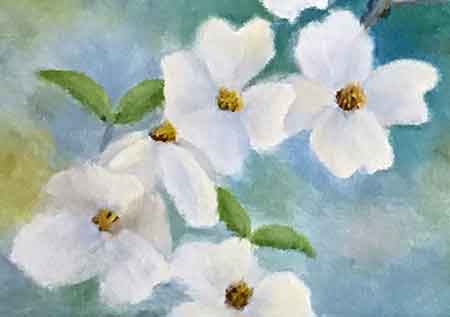 Make final adjustments on the flowers
Make final adjustments on the flowersThe sun is coming from the top right.
Use a warm white mixed with a bit of yellow or orange for warm sunny side.
The shadow side of the petals will have a bit of blue or light grey mixed with white.
it's your turn to paint!
You can do oil painting for beginners!
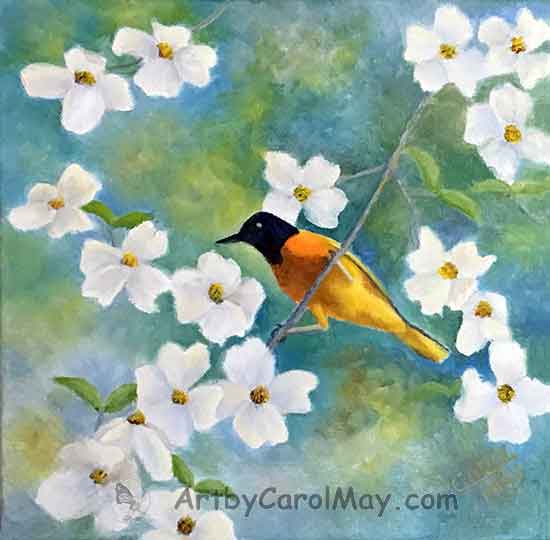 Enjoying the gifts of God, an Oriole and Dogwood
Enjoying the gifts of God, an Oriole and DogwoodGet your oil painting supplies and start painting.
When you are learning how to paint, relax and enjoy yourself. You don't have to paint like a photograph. Paint from your heart and express yourself.
That is a lot
more fun! That's why we paint.
i wish you many successful paintings!
Try some of the other how-to paint pages. The more we paint, the faster we progress.
Recent Articles
-
You Can Paint Butterfly Art!
Apr 21, 24 08:31 AM
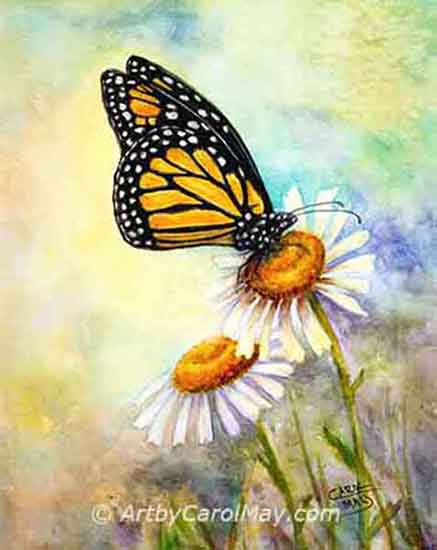 Unlock your creativity and start painting butterfly art. Discover the techniques of painting realistic butterflies. Link to 5 different pages on how to paint butterflies with tips and valuable insight…
Unlock your creativity and start painting butterfly art. Discover the techniques of painting realistic butterflies. Link to 5 different pages on how to paint butterflies with tips and valuable insight… -
Learning to Paint
Mar 29, 24 12:00 PM
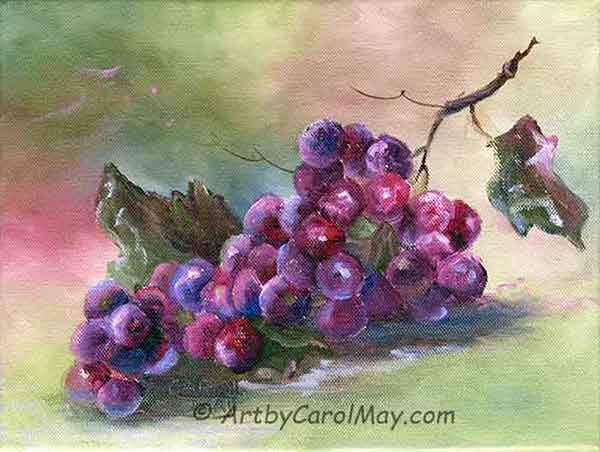 Learning to paint is fun! Millions of people are painting and you can too!
Use these five easy things to jump start your painting journey.
Learning to paint is fun! Millions of people are painting and you can too!
Use these five easy things to jump start your painting journey. -
Easy Butterfly Painting: Watercolor Monarch Step-by-Step Tutorial
Mar 25, 24 03:39 PM
Get creative with an easy butterfly painting tutorial. Discover the joy of drawing and painting a vibrant Monarch Butterfly with simple watercolor techniques. -
Overcoming an Artist's Block
Mar 15, 24 12:00 PM
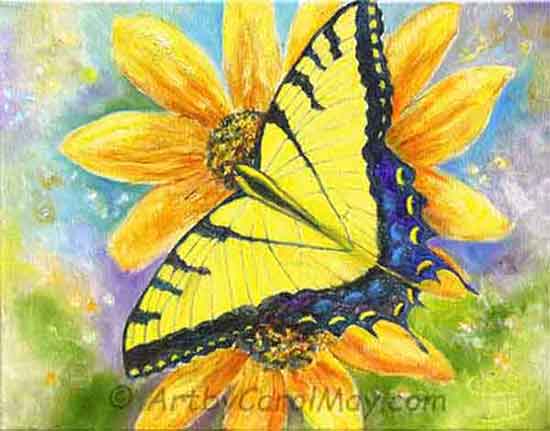 How to survive an artist's block. All artists can have blocks or delays, but we get over it.
What is an art block? How do we get started painting again?
How to survive an artist's block. All artists can have blocks or delays, but we get over it.
What is an art block? How do we get started painting again?
Recent Articles
-
You Can Paint Butterfly Art!
 Unlock your creativity and start painting butterfly art. Discover the techniques of painting realistic butterflies. Link to 5 different pages on how to paint butterflies with tips and valuable insight…
Unlock your creativity and start painting butterfly art. Discover the techniques of painting realistic butterflies. Link to 5 different pages on how to paint butterflies with tips and valuable insight… -
Learning to Paint
 Learning to paint is fun! Millions of people are painting and you can too!
Use these five easy things to jump start your painting journey.
Learning to paint is fun! Millions of people are painting and you can too!
Use these five easy things to jump start your painting journey. -
Easy Butterfly Painting: Watercolor Monarch Step-by-Step Tutorial
Get creative with an easy butterfly painting tutorial. Discover the joy of drawing and painting a vibrant Monarch Butterfly with simple watercolor techniques. -
Overcoming an Artist's Block
 How to survive an artist's block. All artists can have blocks or delays, but we get over it.
What is an art block? How do we get started painting again?
How to survive an artist's block. All artists can have blocks or delays, but we get over it.
What is an art block? How do we get started painting again?







